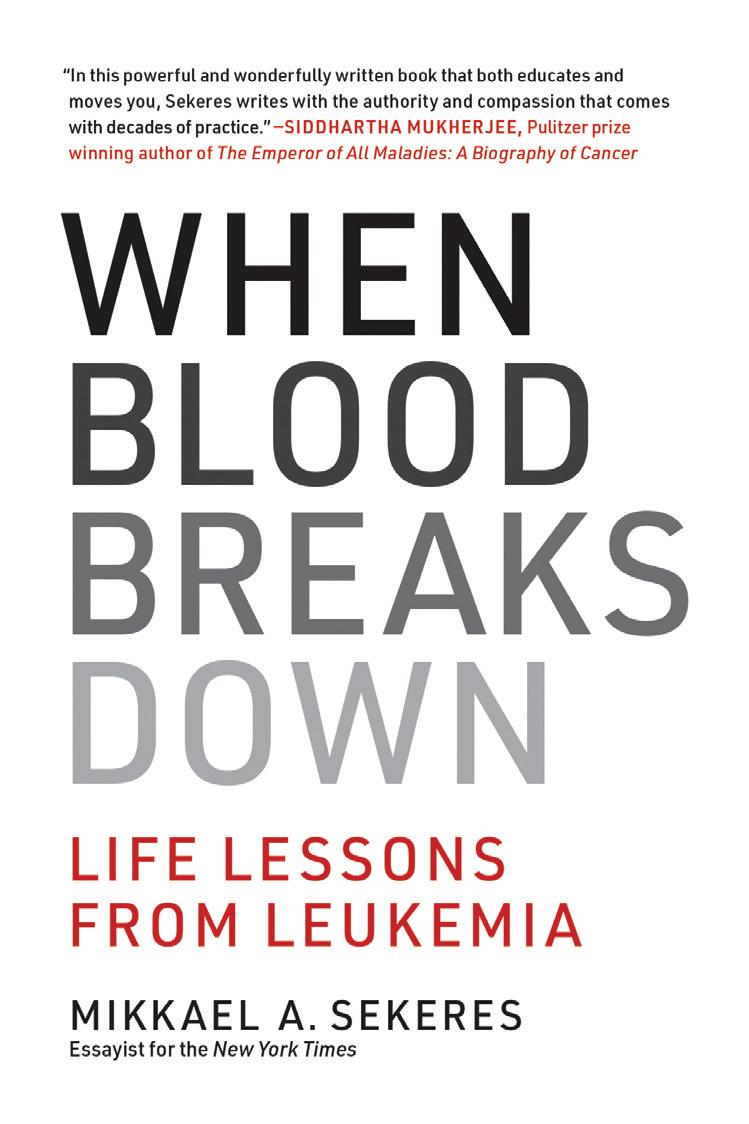
9 minute read
Paperback Reprints
science | medicine
When Blood Breaks Down
Advertisement
Life Lessons from Leukemia Mikkael A. Sekeres
When you are told that you have leukemia, your world stops. In When Blood Breaks Down, Mikkael Sekeres, a leading cancer specialist, takes readers on the journey that patient and doctor travel together. Sekeres, who writes regularly for the Well section of the New York Times, tells the compelling stories of three people who receive diagnoses of adult leukemia within hours of each other: Joan, a 48-year-old surgical nurse, a caregiver who becomes a patient; David, a 68-year-old former factory worker who bows to his family’s wishes and pursues the most aggressive treatment; and Sarah, a 36-year-old pregnant woman who must decide whether to undergo chemotherapy and put her fetus at risk.
We join the intimacy of the conversations Sekeres has with his patients as he explores leukemia in its different forms and the development of drugs to treat it. The lessons to be learned from leukemia, Sekeres shows, are not merely medical; they teach us about courage and grace and defying the odds.
Mikkael A. Sekeres, MD, is Chief of the Division of Hematology in the Sylvester Comprehensive Cancer Center, University of Miami Miller School of Medicine.
“A quiet chronicle of life with and beyond leukemia, and sometimes life’s end.” —Washington Post
“A fascinating debut. . . . This is a powerful look at a disease that forces patients to make ‘decisions that no person should ever have to make.’” —Publishers Weekly
A leading cancer specialist tells the compelling stories of three adult leukemia patients and their treatments, the disease itself, and the drugs developed to treat it.

April 5 3/8 x 8, 328 pp. 22 illus.
US $17.95T/$23.95 CAN paper
978-0-262-54225-8
cloth 978-0-262-04372-4
current events | technology
Coding Democracy
How Hackers Are Disrupting Power, Surveillance, and Authoritarianism
Maureen Webb foreword by Cory Doctorow
Hackers have a bad reputation, as shady deployers of bots and destroyers of infrastructure. In Coding Democracy, Maureen Webb argues that hackers can be vital disruptors. Hacking is becoming a practice, an ethos, and a metaphor for a new wave of activism in which ordinary citizens are inventing new forms of distributed, decentralized democracy for a digital era. Confronted with concentrations of power, mass surveillance, and authoritarianism enabled by new technology, the hacking movement is trying to “build out” democracy into cyberspace. Webb describes an amazing array of hacker experiments that could dramatically change the current political economy. These ambitious hacks aim to displace such tech monoliths as Facebook and Amazon; enable worker cooperatives to kill platforms like Uber; give people control over their data; automate trust; and provide citizens a real say in governance, along with capacity to reach consensus. Coding Democracy provides the tools for an urgently needed upgrade of democracy in the digital era.
Maureen Webb is a labor lawyer and human rights activist. She is the author of Illusions of Security: Global Surveillance and Democracy in the Post-9/11 World and has taught national security law as an Adjunct Professor at the University of British Columbia.
“A powerful case for the fact that technology as we know it—omnipresent, flawed, world-improving—has become so entrenched and static that it really does need the hackers worrying the edges of its firewalls.” —WIRED, 13 Must-Read Books for Spring 2020
March | 6 x 9, 416 pp.
US $17.95T/$23.95 CAN paper
978-0-262-54228-9
cloth 978-0-262-04355-7 business | psychology
The Power of Experiments
Decision Making in a Data-Driven World Michael Luca and Max H. Bazerman
Have you logged into Facebook recently? Chosen a movie on Netflix? If so, you’ve probably been an unwitting participant in a variety of experiments—also known as randomized controlled trials—designed to test the impact of different online experiences. In this book, Michael Luca and Max Bazerman explain the importance of experiments for decision making in a data-driven world. They describe the central role experiments play in the tech sector, drawing lessons and best practices from the experiences of such companies as StubHub, Alibaba, and Uber. Successful experiments can save companies money—eBay, for example, discovered how to cut $50 million from its yearly advertising budget—or bring to light something previously ignored, as when Airbnb was forced to confront rampant discrimination by its hosts. Moving beyond tech, Luca and Bazerman consider experimenting for the social good—different ways that governments are using experiments to influence or “nudge” behavior ranging from voter apathy to school absenteeism.
Michael Luca is Lee J. Styslinger III Associate Professor of Business Administration at Harvard Business School. His writing has appeared in publications including the Atlantic, Wall Street Journal, Harvard Business Review, and Slate. Max H. Bazerman is Jesse Isidor Straus Professor of Business Administration at Harvard Business School. He is the author of The Power of Noticing and the coauthor of Blind Spots, Negotiation Genius, and other books.
“Physics, chemistry, and medicine have had their revolution. But now, driven by experimentation, a further transformation is in the air.” —New Yorker
“Luca and Bazerman balance their passion for experiments with a recognition of its limits.” —Wall Street Journal
March | 6 x 9, 232 pp. | 4 illus.
US $19.95T/$25.95 CAN paper
978-0-262-54227-2
math
Sleight of Mind
75 Ingenious Paradoxes in Mathematics, Physics, and Philosophy Matt Cook
Paradox is a sophisticated kind of magic trick. A magician’s purpose is to create the appearance of impossibility, to pull a rabbit from an empty hat. Yet paradox works in the abstract, with words and concepts and symbols, to create the illusion of contradiction. In Sleight of Mind, Matt Cook and a few collaborators dive deeply into more than 75 paradoxes in mathematics, physics, philosophy, and the social sciences. Cook helps readers discover the meaning of knowledge and the proper formation of concepts—and how reason can dispel the illusion of contradiction. Readers will travel from Ancient Greece to cutting-edge laboratories, encounter infinity and its different sizes, and discover mathematical impossibilities inherent in elections. They will tackle conundrums in probability, induction, geometry, and game theory; explore the strange quantum world—and much more.
Matt Cook, PhD, is an economist, bestselling author, and magician. Among his works are the thriller novel Sabotage and entrepreneurial success book The Startup Star, which he wrote at Stanford University. Trained at the world-famous Magic Castle, he has performed across the globe and enjoys infusing talks and lectures with sleight of hand. Learn more at www.visitmatt.com.
“In this fun, brain-twisting book, Matt Cook and collaborators examine an impressive list of apparently self-contradictory scenarios, only to explain away the puzzles using logic and science.” —Sean Carroll, theoretical physicist and New York Times bestselling author of Something Deeply Hidden
April | 6 x 9, 368 pp. | 79 illus.
US $24.95T/$33.95 CAN paper
978-0-262-54229-6
cloth 978-0-262-04346-5 game studies
The Aesthetic of Play
Brian Upton
The impulse toward play is not only pre-cultural but prehuman; zoologists have identified play behaviors in turtles and in chimpanzees. Games have existed since antiquity; 5,000-year-old board games have been recovered from Egyptian tombs. And yet we still lack a critical language for thinking about play. Game designers are better at answering small questions (“Why is this battle boring?”) than big ones (“What does this game mean?”). In this book, the game designer Brian Upton analyzes the experience of play—how playful activities unfold from moment to moment and how the rules we adopt constrain that unfolding.
Drawing on games that range from Monopoly to Dungeons & Dragons to Guitar Hero, Upton develops a framework for understanding play, introducing a set of critical tools that can help us analyze games and game designs and identify ways in which they succeed or fail.
Brian Upton co-founded Red Storm Entertainment, where he was lead designer of the popular games Rainbow Six and Ghost Recon. He is now a “script doctor for games” at Sony’s Santa Monica Studio.
“This book blasts through the sterile dogmas of game studies with a model of play that unites stories, games, and criticism into diverse unity.” —Chris Bateman, Ph.D., game designer, philosopher, and author
“Upton’s book is a rarity in game design and development texts— it provides a new way of understanding games both analog and digital that is innovative, tangible, and incredibly valuable for an evolving medium.” —Brenda Romero, game designer, Romero Games
February | 6 x 9, 36 pp. | 56 illus.
US $25.95T/$34.95 CAN paper
978-0-262-54263-0
cloth 978-0-262-02851-6
science | cultural studies
Technologies of the Human Corpse
John Troyer
Death and the dead body have never been more alive in the public imagination. In this unique work, John Troyer examines the relationship of the dead body with technology, both material and conceptual: the physical machines, political concepts, and sovereign institutions that humans use to classify, organize, repurpose, and transform the human corpse. Troyer explains how technologies of the nineteenth century, including embalming and photography, created our image of a dead body as quasiatemporal, existing outside biological limits formerly enforced by decomposition. He describes the “Happy Death Movement” of the 1970s; the politics of the HIV/AIDS corpse and the productive potential of the dead body; the provocations of the Body Worlds exhibits and their use of preserved dead bodies; and the black market in human body parts. The consequences of total control over death and the dead body, Troyer argues, are not liberation but the abandonment of Homo sapiens as a concept and a species.
John Troyer is Director of the Centre for Death and Society and Associate Professor in the Department of Social and Policy Sciences at the University of Bath. He grew up in the American funeral industry.
“Troyer charts the unexpectedly complex history of the dead body, and the various technical advances that have transformed our relationship with it.” —Financial Times
“Troyer is one of our greatest thinkers on the ways technology and capitalism continue to transform the idea of the human corpse.” —Caitlin Doughty, mortician and bestselling author of Smoke Gets in Your Eyes
March | 5 3/8 x 8, 272 pp. | 12 illus.
US $17.95T/$23.95 CAN paper
978-0-262-54231-9
cloth 978-0-262-04381-6 nature
Animal Languages
Eva Meijer translated by Laura Watkinson
Is language what sets humans apart from other animals, as many have argued? Or do animals speak in their own languages, to each other and to us? In Animal Languages, Eva Meijer explores the latter possibility. Meijer tells us about Alex, the gray parrot who knew more than one hundred words, and Chaser, the border collie who had a talent for grammar. She introduces us to Washoe, the chimpanzee who grew up with humans and learned sign language; Kosik, the elephant who spoke to humans in human language and to his female elephant companion in elephant language; and Noc, the beluga whale who mimicked human speech. She tells us that dogs are able to interpret the meaning of other dogs’ growls and that marmosets take turns in conversations and teach this skill to their offspring.
But beyond all these interesting details, Meijer makes a more profound observation. Talking with animals forces us to challenge the hierarchy of humans and other animals, and suggests a new way of thinking about language. Animal Languages shows us that language is broader and richer than we imagined, and that meaningful expression does not require human words.
Eva Meijer is an author, artist, singer, songwriter, and philosopher. She is author of Bird Cottage, a novel.
“Meijer reveals fascinating research into how animals communicate.” —Guardian
“Ambitious.” —New York Review of Books
February | 5 3/8 x 8, 288 pp.
US $17.95T paper
978-0-262-54230-2
cloth 978-0-262-04403-5






